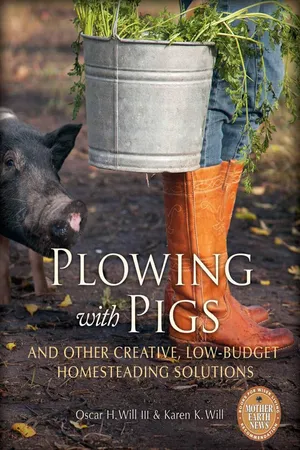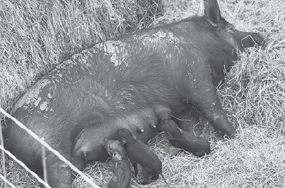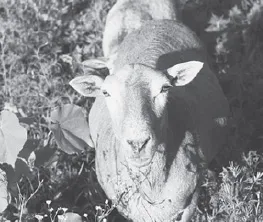![]()
Section 1
Animals
Fowl, hogs, and small ruminants such as sheep and goats are hallmarks of the 21st-century’s rural homestead. Flocks of chickens, at the very least, characterize urban and suburban versions of the same. Though sometimes raised as pets or for some specific commodity like fiber, eggs, or meat, domesticated farm animals of all kinds can empower you to do more with less — even if you have no intention of eating the animals. Chickens can rid your yard of ticks and other insect pests, sheep can mow the lawn, and goats will gladly rid your pastures and fence lines of poison ivy and woody brush. These animals provide not only rich, organic fertilizers to help build soil, they can also provide endless hours of entertainment.
Understanding a specific breed’s or species’ behavioral biology is the first step to finding ways to put animal allies to work. The goal is to simply allow them to do what comes naturally. Casting some conventional thinking to the wind is the second step; our ancestors knew to let animals work for them, but today’s highly controlled industrial agriculture models don’t have room for letting animals do their thing. The final step in getting animals to do some of your pesky work is to give it a try and have some fun with it.
In the following three chapters, we consider some of our ancestors’ animal understanding — with a 21st-century twist.
![]()
CHAPTER 1
Free-Range Fowl
At the turn of the 20th-century, a common sight in backyards and farms throughout the country was the family cow, a small chicken flock, and even the occasional shoat being fattened on kitchen scraps. Over the years, as folks sought to prove they were sophisticated and not “fresh from the farm,” municipal codes were changed. Residents were denied the right to keep animals that had provided a measure of self-sufficiency. So thorough was the campaign against chickens that many people now view Gallus gallus as the source of every potential sanitation and nuisance problem in a city. Code enforcement officers would have you believe that chickens by their very nature “attract vermin” (such as mice and rats), “draw flies,” or literally “raise a stink.” Plus chickens are noisy. Ha!
Truth be told, chickens don’t attract mice and flies, but they do relish eating any that do show up. They’ll eat every fly larva they find. And when chickens are kept in a proper coop or sufficient-sized yard, their manure is never sufficiently moist or concentrated to generate an offensive ammonia odor. And even if manure builds up below their perches, chickens will naturally scratch through that manure and the bedding, which keeps the decomposition process aerobic. We don’t deny that roosters can be annoyingly loud in town, but the murmuring discussion among contented hens can hardly be called loud. And even when the girls announce the impending arrival of an egg, that clucking is not as loud or annoying as a barking dog — yet, dogs are allowed virtually everywhere. Not so the chicken.
We’re pleased to report that the chicken has made a comeback! Twenty-first-century homesteaders living out where the pavement ends are adding flocks in droves, and people living in town and suburbia are demanding their right to keep chickens by working to get their municipal codes changed. In most cases, urban homesteaders are legally limited to the number (and in some cases, the type) of chickens they can keep, but the birds are reclaiming their place in North American backyards one town at a time. There are many reasons to factor chickens into your homesteading plans — even if you have no intention of eating any part of the chicken or its byproducts.
New Work for Old Chickens
Back in the day, fowl fanciers and farmstead owners all over the country kept chickens because they were beautiful, particularly suited to a specific region’s environment, and for the services they could offer and/or products they could supply. Did you know that some fancy fowl were kept to supply the fashion and fishing-fly-tying industries with incredibly beautiful feathers, which were often harvested without ending the bird’s life? Others were kept for the eggs or meat they could provide. And all the while, the birds kept their premises free of all manner of pests, including flies, ticks, grubs, caterpillars, and even mice and snakes in some instances. Plus, chickens are an end-of-the-day entertainment that rivals the best Broadway show or blockbuster movie. You’ve heard the expression “sit and watch the chickens peck.” For the homesteader, there may be nothing quite so soothing at the end of a fulfilling day of work than to sit, cool beverage in hand, and watch the chickens just do what chickens do.
Fig. 1.1: Chickens left to roam freely will till the soil in your perennial beds and keep insect pests at bay as well as add beauty to the landscaping.
CREDIT: OSCAR H. WILL III
So, what is it that they do? Well, if the chickens in question happen to be one of the small handful of over-bred industrial breeds, those poor animals will have few social skills and may grow so fast and so out of proportion that they break bones or die of heart attacks just eight weeks after hatching. Watching these chickens do their thing may be more depressing than relaxing or uplifting — especially if they’re in a horrific factory-production setting — but that’s not their fault. It’s the fault of our morally bankrupt, so-called land-grant-university animal science departments, which — in collusion with the very industry profiting from the “research” — have determined that animals such as chickens are nothing more than cogs in a money-making machine. As such, laying hens may legally be crowded into small cages where they cannot scratch, cannot interact socially with one another, and cannot lay eggs in the privacy of a nest box or other “secret” place. On top of all of that, most of the top-half of their beaks have been cut off to keep the overcrowded animals from pecking one another.
Thankfully, a sufficient number of folks interested in animal husbandry eschewed the entire industrial poultry production model and have maintained many of the old chicken breeds and lines. Thus it is that some of those sturdy, older breeds are available today. Birds like the Jersey Giant will net you some eggs and grow to sufficient size to produce a fine table fowl. But more importantly, old breeds like the Jersey Giant thrive out-of-doors, and they will entertain you beautifully while performing tasks you’d rather not do and doing the work of agricultural poisons and synthetic chemicals you’d rather not use.
Fig. 1.2: Lead your flock to fresh forage using one of their favorite treats such as a mixture of grains.
CREDIT: OSCAR H. WILL III
Chickens in the Yard
Whether you live in town or out in the country, keeping a small flock of chickens in the backyard is not only fun, it’s rewarding in a number of ways. As omnivores, chickens will gleefully seek out and devour all manner of insect, bug, grub, larva, worm, mouse, etc. They will also mow your lawn — to an extent, anyway. Chickens relish fresh greens, including grasses and forbs. When they are confined in relatively small areas, they can keep the lawn trimmed (though, when left to their own devices, they have a tendency to overgraze their favorite things, like clover and dandelions, and spend less time on the Kentucky bluegrass). If you enclose your birds in a portable pen, you can move it around the yard in a rotation, and your chickens will do a much more uniform mowing job than when they are completely free-ranging. So, moving them around in a pen can either keep the birds from overgrazing their favorite vegetation or it can encourage them to do just that — to help you prepare a new garden patch. As the chickens graze, they’ll fertilize the lawn with some of the finest organic material out there, but they’ll do oh-so-much more.
If you are a lawn purist, you might de-thatch your yard every spring. This arduous task involves hard, soil-scratching raking that pulls up the thatch of dead grass that collects just above the soil surface each year. Alternatively, you might rent an expensive gas-guzzling power de-thatcher that will scratch the soil, while bringing all that dead grass to the surface for easier collection with a leaf rake or power vacuum of some kind. In either case, you are expending all kinds of calories to undo something that mowing redoes every year. Plus, de-thatching can make some turf grass crowns more susceptible to various pests. Here’s where the chickens come in.
When left to their own devices, hens will scratch the ground looking for worms, grubs, and other likely food sources. When given plenty of space, or moved around in portable (and bottomless) pens, this scratching will de-thatch and aerate the lawn while breaking the thatch into smaller, more easily decomposed pieces. The end result is that the chicken de-thatchers will render the thatch gone and promote its decomposition in place. You don’t have to collect the debris and send it to the landfill or put it in your compost bin. Plus, you can employ chickens year-round to keep the thatch under control. At the same time, they’ll keep the lawn fertilized and help control grubs, bugs, and ticks. Chickens do all this and more for the price of a little bit of feed.
Even if you keep sufficient chickens to handle most of the mowing, you might still choose to mow the front yard more formally. Many people who mow with machines collect their grass clippings in black plastic trash bags which are then dutifully sent to the landfill every week throughout the summer. It’s true that some folks add the clippings onto their compost pile, but those piles often turn into stinking anaerobic messes because clippings have a relatively high protein content. But there is completely different way of accomplishing the task of mowing. Instead of using machines, you can take advantage of the fact th...







